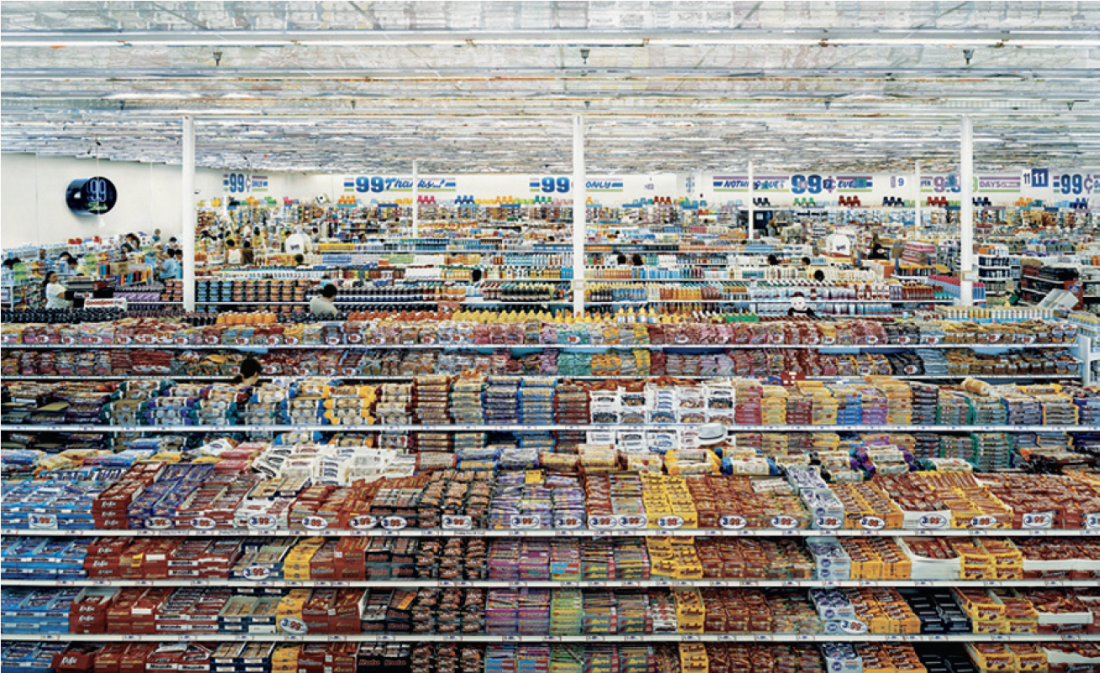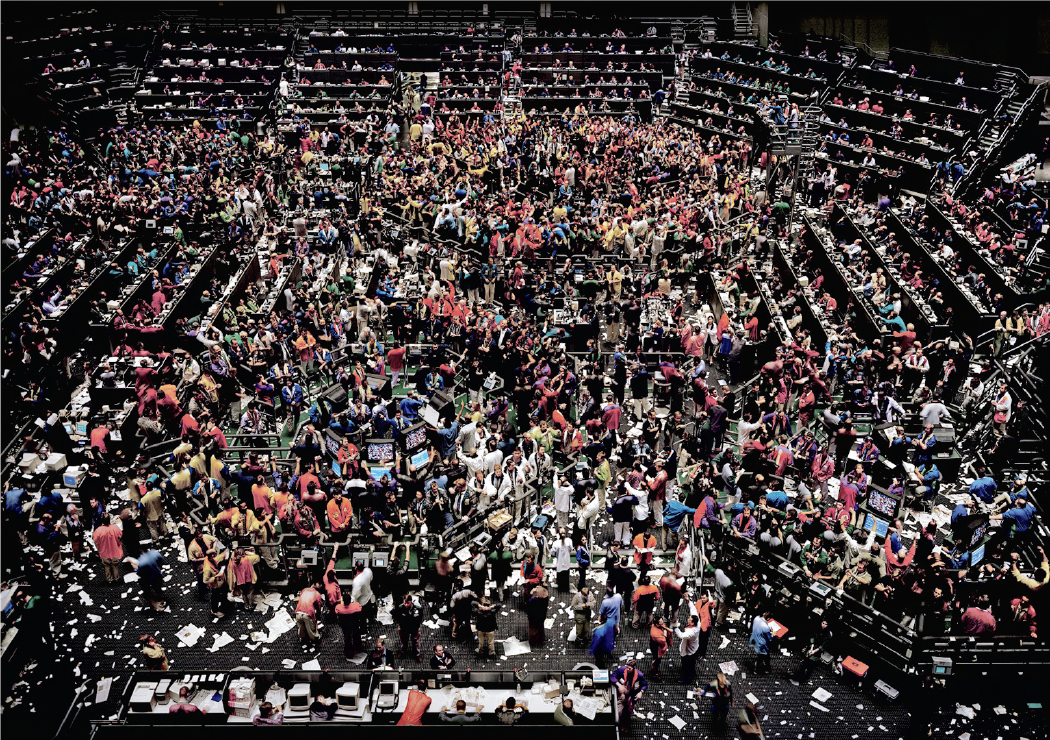Andreas Gursky
Andreas Gursky’s work is often referred to as monumental. In terms of scale, physical presence and technical dazzle, rightly so. With photography competing with painting for wall space in the art institution, Andreas Gursky’s work seems a natural fit for the museum and its need for crowd-magnet shows. Full of detailed gigantic photographs connecting industry, finance, mass production and globalization, his work acts as shorthand for a particular style of photography produced by contemporaries like Thomas Struth and Thomas Ruff. The trio—also known as “Struffsky”—trained under Bernd and Hilla Becher, part of the Dusseldorf School that broke internationally in the ’80s. Since then, Gursky’s sober “Becher-schule” approach and his Photoshop experiments have paid off handsomely, and this retrospective provided a good opportunity to visit, revisit or even reappraise his work.
His iconic ’90s works have earned their place on the art historical timeline, pushing the photograph’s potential as digital technology insinuated itself into the medium. Rather than just taking pictures, Gursky’s talent is in producing images, constructing the appearance of an objective gaze out of a straight-looking documentary approach. Key works like the stoic modernist grid of Montparnasse, 1993, and his high definition homage to the dollar store, 99 Cent, 1999, are genuinely breathtaking in person, their status as big-ticket commodities evident. Intimidatingly huge and incredibly sharp in detail, they look expensive, and it’s hard not to be overwhelmed since the only other thing in the gallery taller than his pictures is the spot where wall meets ceiling.

Andreas Gursky, 99 Cent, 1999, C-Print, 207 x 325 x 6.2 cm. Courtesy Sprüth Magers Berlin London. Photograph: © Andreas Gursky/JASPER, 2014.
His expansive topography and “business as usual” treatment of architecture and people in their living, shopping, leisure, sport and industrial zones seems matter-of-fact, but there’s a subtle criticality at work. Images like Bonn Parliament, 1998, and Chicago Board of Trade III, 1999, manage to lift the lid on places of power, making boys’ clubs look like ant farms and bee colonies, and you could match his images up with an old copy of Adbusters, some Edward Burtynsky and a viewing of the ’80s film Koyaanisqatsi as part of an effective pictorial guide to late capitalism. There’s a timelessness to these works, uncannily so, looking outside the frame post-2008/financial meltdown: dollar stores abound, sweatshops still crank out crap to fill them, and amusingly, a Gursky in the art market is affordable for “the one percent” while everyone else gets to buy the postcard in the gift shop.
To wit: I was curious to finally see Rhein II, 1999, an image of the banks of the Rhine River with all the people and buildings digitally removed, the picture plane a tranquil set of horizontal strips of grey and green. It recently sold for $4.3 million at Christie’s, eclipsing Gursky’s own masterpiece, 99 Cent Diptychon, 2001, as the most expensive photograph (the latter flipped for $3,346,456 in 2007). After generating the usual boilerplate controversy as op-eds and internet comment sections cried foul—“THATS NOT ART!!” and “You paid HOW MUCH for that?!”—I was surprised to see that the display print was so, well, small.
The amount of work required to make the work seems daunting, and technology—or perhaps the dependence on it to achieve desired effects—weakens much of his later output. There’s still the lofty view, the overall unity of each tiny element in sharp focus, the infinite depth of field with multiple vantage points digitally sewn-in and flattened out; everything becomes so “just so,” or perhaps too much so that his condensed versions of the physical world slowly begin to feel airless, hyper-mediated and micromanaged. Works like Cathedral I, 2007, and Bahrain I, 2005, overreach like a movie trying to ignore its own cheesy CG effects, trading the sublime for an over-processed, slick look. F1 Pit Stop IV, 2007, maxes out at around five metres across, spectacular like a Renaissance painting à la Veronese, while his “Bangkok” series (2011) almost pays off with large abstracts of watery, painterly curves on a black ground: reflections on the polluted surface of the Chao Phraya River with the occasional discarded tire or bobbing bit of trash as conceptual anchor. By pushing pictorality to a point where the composition becomes a seamless composite, his fictions ask questions about what constitutes a photograph. At some point you stop looking at them as such, and it’s probably best to enjoy them for their grand sweep.

Andreas Gursky, Chicago Board of Trade III, 1999, C-Print, 223 x 307 x 6.2 cm. Courtesy Sprüth Magers Berlin London. Photograph: © Andreas Gursky/JASPER, 2014.
Pyongyang I, 2007, for instance, is one of his strongest works: a striking, high-resolution image of North Korea’s Arirang mass games where thousands of human pixels create a socialist-realist tableau in honour of Juche, the North Korean political philosophy, and the Kim dynasty. Interestingly, it was the one piece most closely scrutinized by gallery-goers: instead of taking five steps back to take it all in, people closed in, examining the faces of individual souls living in a dictatorship that’s equally horrifying and fascinating. And why not? When the Western media talks of “sabre-rattling” in Pyongyang, Osaka is close enough that you can hear it.
An interesting curatorial move was to not display the work in chronological order. Pleasant discoveries included restrained and simple graphic works that played against type, like the circular modernist light fixture in Paris, PCF, 2003, and the uniform, institutional grey of 1999’s Untitled I (Carpet). Also scattered throughout were works from the powerful yet simple series Ocean I-VI, 2009–2010, sourced from high-definition satellite images of the earth. They were thrilling to view, due in part to the momentary sense of vertigo looking down from space before logic and gravity rights itself in the gallery. After absorbing so much detail throughout the show, simply gazing at the tranquil nothing of deep blue-green between the greys and whites of land from on high—however digitally finessed—was more than welcome. ❚
“Andreas Gursky” was exhibited at The National Museum of Art, Osaka, Japan, from February 1 to May 11, 2014.
Christopher Olson (@standardgrey) is a frequent contributor to Border Crossings. Two recent text-based visual works appear in The Last Vispo Anthology: 1998–2008, published by Fantagraphics. He lives in Nara, Japan.

